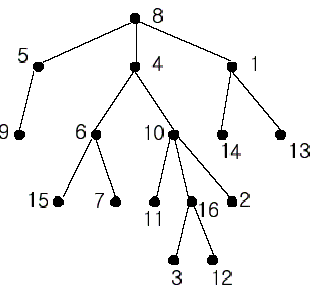|
Language:
Nearest Common Ancestors
Description
A rooted tree is a well-known data structure in computer science and engineering. An example is shown below:

In the figure, each node is labeled with an integer from {1, 2,...,16}. Node 8 is the root of the tree. Node x is an ancestor of node y if node x is in the path between the root and node y. For example, node 4 is an ancestor of node 16. Node 10 is also an ancestor of node 16. As a matter of fact, nodes 8, 4, 10, and 16 are the ancestors of node 16. Remember that a node is an ancestor of itself. Nodes 8, 4, 6, and 7 are the ancestors of node 7. A node x is called a common ancestor of two different nodes y and z if node x is an ancestor of node y and an ancestor of node z. Thus, nodes 8 and 4 are the common ancestors of nodes 16 and 7. A node x is called the nearest common ancestor of nodes y and z if x is a common ancestor of y and z and nearest to y and z among their common ancestors. Hence, the nearest common ancestor of nodes 16 and 7 is node 4. Node 4 is nearer to nodes 16 and 7 than node 8 is. For other examples, the nearest common ancestor of nodes 2 and 3 is node 10, the nearest common ancestor of nodes 6 and 13 is node 8, and the nearest common ancestor of nodes 4 and 12 is node 4. In the last example, if y is an ancestor of z, then the nearest common ancestor of y and z is y. Write a program that finds the nearest common ancestor of two distinct nodes in a tree. Input
The input consists of T test cases. The number of test cases (T) is given in the first line of the input file. Each test case starts with a line containing an integer N , the number of nodes in a tree, 2<=N<=10,000. The nodes are labeled with integers 1, 2,..., N. Each of the next N -1 lines contains a pair of integers that represent an edge --the first integer is the parent node of the second integer. Note that a tree with N nodes has exactly N - 1 edges. The last line of each test case contains two distinct integers whose nearest common ancestor is to be computed.
Output
Print exactly one line for each test case. The line should contain the integer that is the nearest common ancestor.
Sample Input 2 16 1 14 8 5 10 16 5 9 4 6 8 4 4 10 1 13 6 15 10 11 6 7 10 2 16 3 8 1 16 12 16 7 5 2 3 3 4 3 1 1 5 3 5 Sample Output 4 3 |
裸的LCA 感谢kuangbin的板子
#include <cstdio>
#include <iostream>
#include <cstring>
#include <cmath>
#include <algorithm>
#include <string.h>
#include <string>
#include <vector>
#include <queue>
#define MEM(a,x) memset(a,x,sizeof a)
#define eps 1e-8
#define MOD 10009
#define MAXN 10010
#define MAXM 100010
#define INF 99999999
#define ll __int64
#define bug cout<<"here"<<endl
#define fread freopen("ceshi.txt","r",stdin)
#define fwrite freopen("out.txt","w",stdout)
using namespace std;
int Read()
{
char c = getchar();
while (c < '0' || c > '9') c = getchar();
int x = 0;
while (c >= '0' && c <= '9') {
x = x * 10 + c - '0';
c = getchar();
}
return x;
}
void Print(int a)
{
if(a>9)
Print(a/10);
putchar(a%10+'0');
}
int rmq[2*MAXN];
struct ST
{
int mm[2*MAXN];
int dp[MAXN*2][20];//最小值对应的下标
void init(int n)
{
mm[0]=-1;
for(int i=1;i<=n;i++)
{
mm[i]=((i&(i-1))==0)?mm[i-1]+1:mm[i-1];
dp[i][0]=i;
}
for(int j=1;j<=mm[n];j++)
for(int i=1;i+(1<<j)-1<=n;i++)
dp[i][j]=rmq[dp[i][j-1]]<rmq[dp[i+(1<<(j-1))][j-1]]?dp[i][j-1]:dp[i+(1<<(j-1))][j-1];
}
//查询[a,b]之间最小值的下标
int query(int a,int b)
{
if(a>b) swap(a,b);
int k=mm[b-a+1];
return rmq[dp[a][k]]<=rmq[dp[b-(1<<k)+1][k]]?dp[a][k]:dp[b-(1<<k)+1][k];
}
};
struct Edge
{
int to,next;
};
Edge edge[MAXN*2];
int tot,head[MAXN];
int F[MAXN*2];//欧拉序列 就是dfs遍历的顺序 长度为2*n-1 下标从1开始
int P[MAXN];//p[i]表示点i在F中第一次出现的位置
int cnt;
ST st;
void init()
{
tot=0;
MEM(head,-1);
}
//加边 无向边需要加两次
void addedge(int u,int v)
{
edge[tot].to=v;
edge[tot].next=head[u];
head[u]=tot++;
}
void dfs(int u,int pre,int dep)
{
F[++cnt]=u;
rmq[cnt]=dep;
P[u]=cnt;
for(int i=head[u];i!=-1;i=edge[i].next)
{
int v=edge[i].to;
if(v==pre) continue;
dfs(v,u,dep+1);
F[++cnt]=u;
rmq[cnt]=dep;
}
}
//查询LCA前的初始化
void LCA_init(int root,int node_num)
{
cnt=0;
dfs(root,root,0);
st.init(2*node_num-1);
}
//查询u,v的lca编号
int query_lca(int u,int v)
{
return F[st.query(P[u],P[v])];
}
bool flag[MAXN];
int main()
{
// fread;
int tc;
scanf("%d",&tc);
while(tc--)
{
int n;
scanf("%d",&n);
init();
MEM(flag,0);
for(int i=1;i<n;i++)
{
int u,v;
scanf("%d%d",&u,&v);
addedge(u,v);
addedge(v,u);
flag[v]=1;
}
int root;
for(int i=1;i<=n;i++)
if(!flag[i])
{
root=i; break;
}
LCA_init(root,n);
int u,v;
scanf("%d%d",&u,&v);
printf("%d\n",query_lca(u,v));
}
return 0;
}
























 427
427

 被折叠的 条评论
为什么被折叠?
被折叠的 条评论
为什么被折叠?








